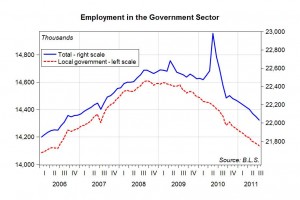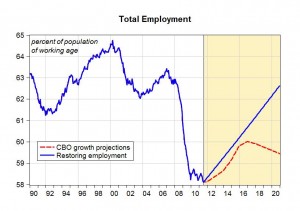To Cut the Debt, Create Jobs
While public discussion in the last several weeks has been absorbed by the debt ceiling saga, and in the coming weeks will probably focus on the S&P downgrade, employment (or lack thereof) is still a major problem. Our employment problem is one of the main factors contributing to a sizeable government deficit and growing public debt.
For all those who think that government has expanded wildly during the recession as a result of the fiscal stimulus, think again. The chart above shows that of the 7.3 million jobs lost since November 2007, 300,000 of those were lost in the government sector; more specifically in local government, which accounts for about 64% of the employment in the government sector. Local governments have to run a balanced budget, and when a recession hits and their tax receipts decline, they have to cut expenses—which means fewer jobs. If the federal government were to embrace similar balanced-budget policies, its ability to support a struggling economy would be severely curtailed. It would not only be unable to create jobs directly; it would struggle to even maintain its existing workforce.
The chart below shows one measure of the employment rate, computed as a percentage of the working-age population. This share rose in the post-WWII period with the increase in the female participation rate. It stabilized in the twenty years before the Great Recession at around 63%, dropped to 58% during the recession, and has remained roughly stable in the last ten months. To see what the prospects are for employment going forward, we have made some simple calculations. Given that the population has been growing roughly 0.9% annually, and projecting the same growth rate for the next nine years, employment needs to rise by roughly 1.8% per year to restore the employment levels the U.S. enjoyed before the recession. This requires adding a little more than 200,000 jobs each month. Since productivity has been rising, on average, at 1.7%, output needs to grow 3.4% every year until 2020 to achieve this simple employment target.
However, if we take the output growth projected by the CBO in its last report—which assumes no further government intervention—and deduct the average growth rate in productivity, we obtain the employment path drawn as a red dashed line in the chart.
With no further government intervention employment will remain a problem for the coming years—and fiscal austerity will make things even worse. Government deficits rise automatically in recessions, since lower incomes reduce tax payments while unemployment benefits increase expenditures. If no new jobs are created, the ability of taxpayers to contribute to the public budget cannot be restored. Hoping to reduce the deficit by cutting public expenses and further reducing the overall well-being of the median household is folly.
Policies to restore employment will reduce the deficit. Policies to cut public debt will eliminate jobs.





 ShareThis
ShareThis